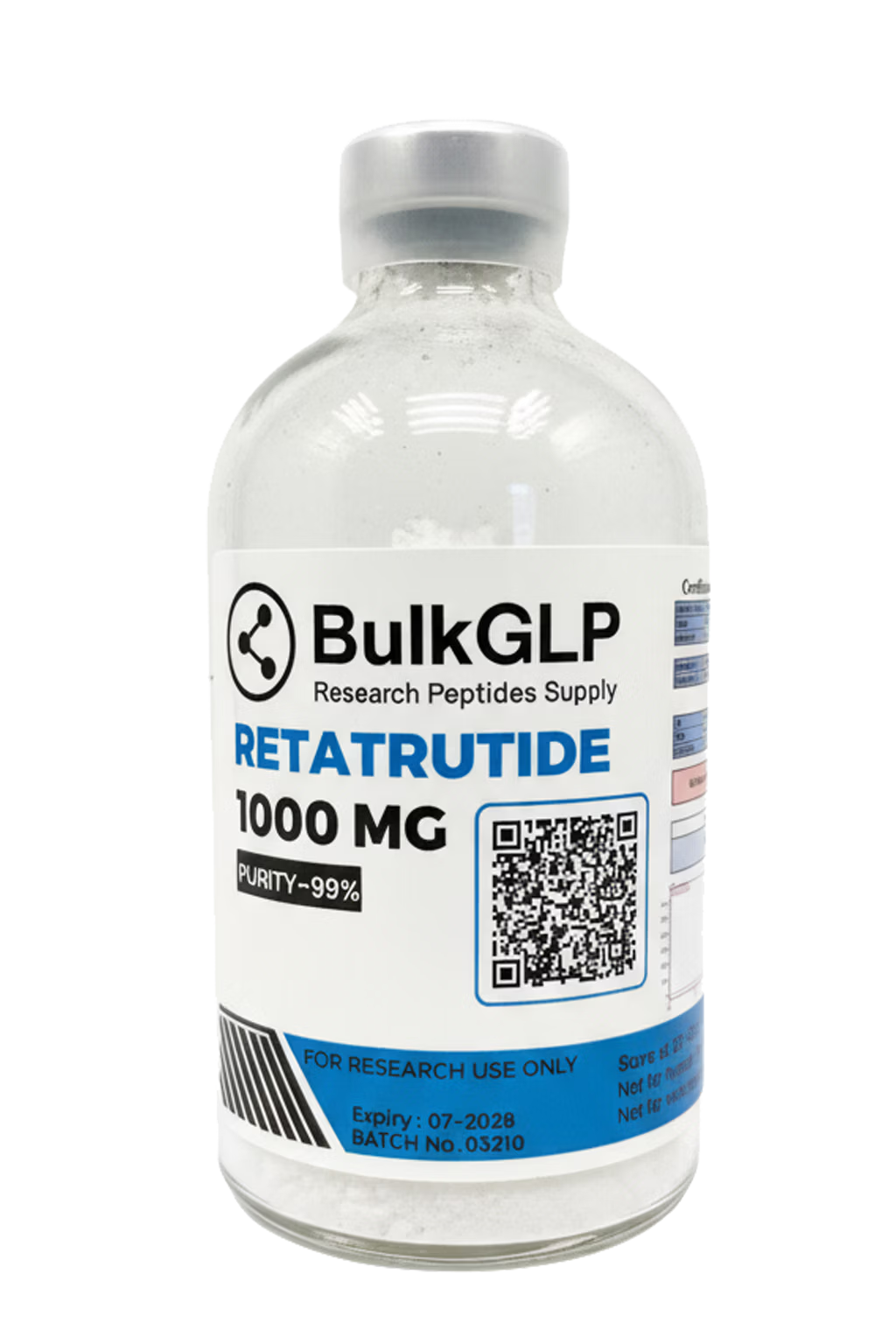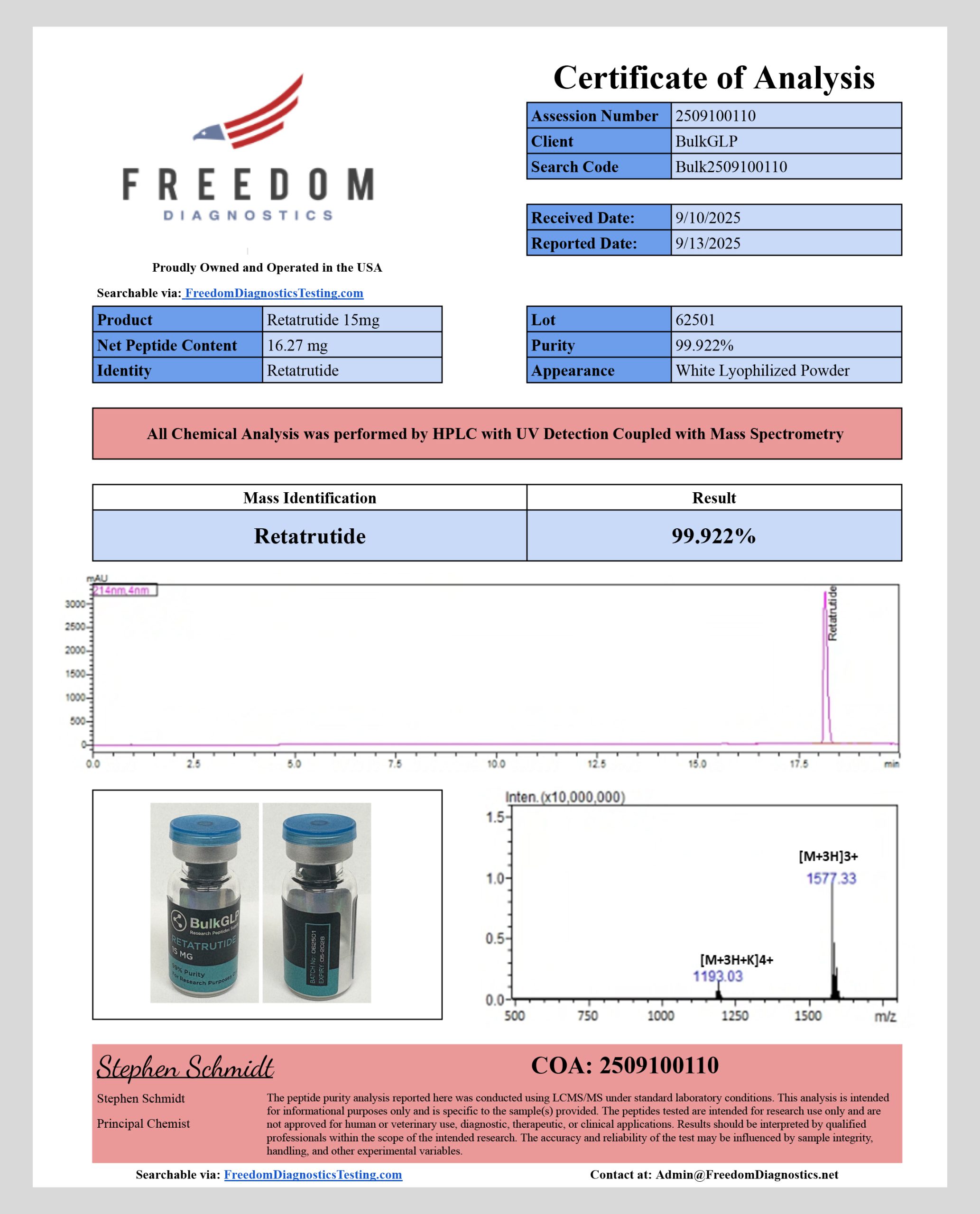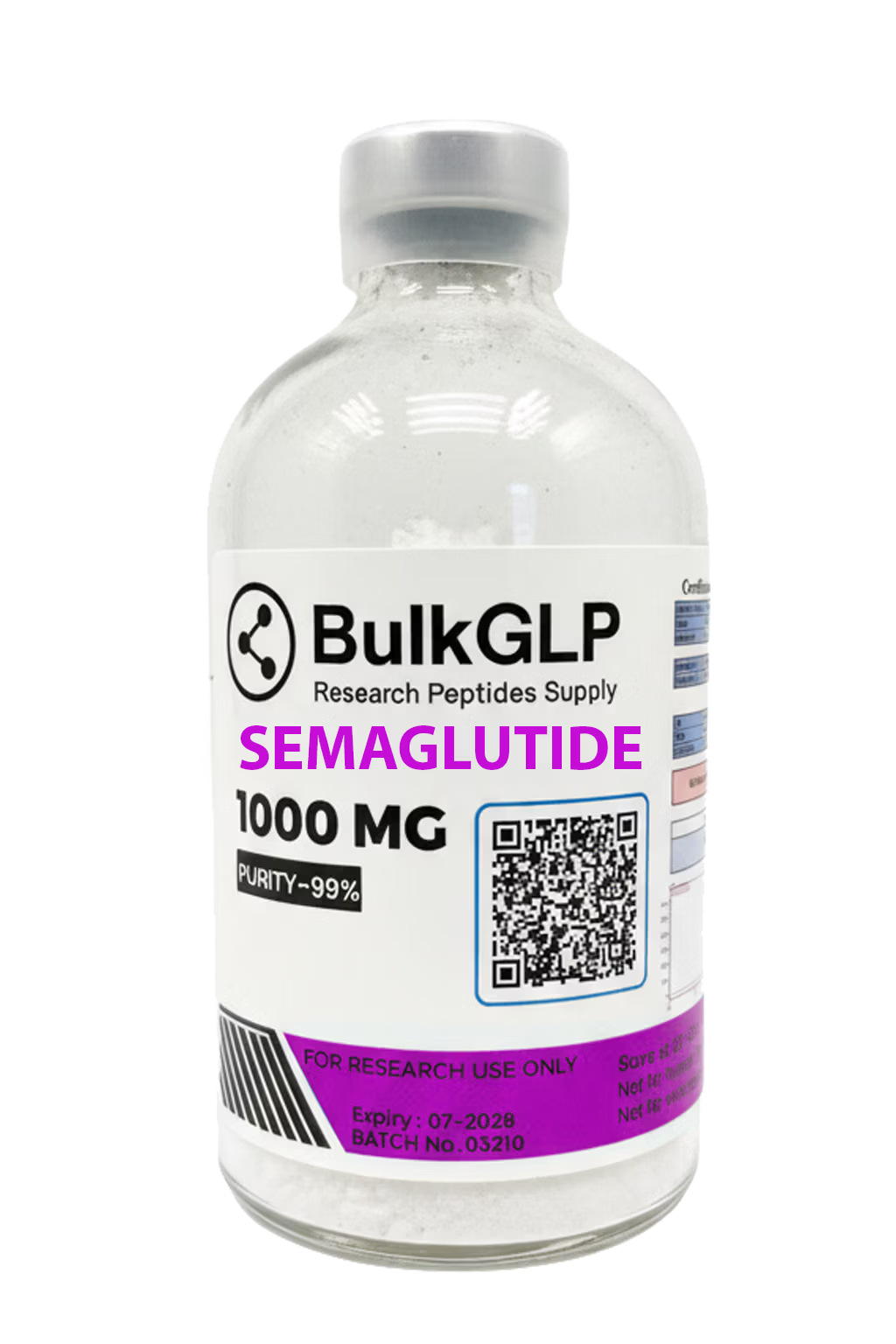Buy Retatrutide Raw Powder (Lyophilized) — 250mg / 500mg / 750mg / 1g
Free Priority Shipping on Orders $99+
In stock —
Retatrutide (LY3437943) Powder — lyophilized, mannitol-free, ≥99% purity (HPLC/MS) with batch COA. Sizes 250mg–1g. Research Use Only.
From $929.00
Buy Retatrutide Powder (Lyophilized) — 250mg / 500mg / 750mg / 1g
Retatrutide (LY3437943) supplied as lyophilized powder for laboratory research (RUO). Third-party HPLC/MS verification with batch COAs. Mannitol-free; no buffers or fillers.
Batch-Matched COA
Mannitol-Free
For Laboratory Research Use Only. Not for human or veterinary use.
Select Quantity
Choose a lot size that fits your workflow. Your storefront’s swatches/options go here.
- 250mg — small series runs
- 500mg — medium programs
- 750mg — extended series
- 1g (1000mg) — highest efficiency per mg
Quality & Documentation
- Independent HPLC/MS; batch COA supplied.
- Consistent lots for longitudinal work.
- Mannitol-free; no buffers or fillers.
Handling
- Work on a clean bench; use calibrated mg scale for aliquoting.
- Reconstitute with bacteriostatic water or suitable research solvent.
- Add gently along vial wall; swirl to dissolve (avoid vigorous shaking).
Available Powder Sizes
| Size | Use Case | Notes |
|---|---|---|
| 250mg | Small series | Flexible aliquoting |
| 500mg | Medium programs | Balanced cost/mg |
| 750mg | Extended runs | Fewer re-orders |
| 1g | High throughput | Best cost/mg |
Specifications
- Synonyms: LY3437943, “GLP-3” triple-agonist (colloquial)
- Purity: ≥99% (HPLC/MS)
- Appearance: White lyophilized powder (collapsed/fragmented cake is normal)
- Molecular Formula: C₂₂₁H₃₄₂N₄₆O₆₈
- Molecular Weight: ≈ 4731.33 g/mol
- Preparation: No mannitol, buffers, or fillers
Storage & Stability
- Lyophilized: ≤ −20 °C; protect from moisture/light.
- After reconstitution: 2–8 °C; minimize freeze–thaw cycles; protect from light.
Retatrutide: Research Overview
Retatrutide (LY3437943) is a laboratory peptide used to investigate multi-receptor metabolic signaling in model systems. Because it is a large, sequence-defined molecule, the usefulness of any given lot depends on precise synthesis, purification, and storage. This powder format is intended for labs that prefer lot-level control—aliquoting, preparing custom concentrations, and running method-consistent assays across time.
Our powder is filler-free. Some suppliers add bulking agents (e.g., mannitol, trehalose) to create a taller cake. We intentionally avoid bulking agents so the solids correspond predominantly to the target peptide, which simplifies mass-based calculations during method development. Visual cake height therefore varies by charge volume and lyophilization profile and should not be interpreted as “under-filled” or “low purity.”
Mannitol-Free vs. Bulking-Agent Preparations
Filler-Free (This Product)
- Maximizes peptide fraction per unit solids.
- Irregular, sometimes thin or sheet-like cake.
- No excipient peaks in chromatography.
With Bulking Agent
- More robust cake for handling; taller visual fill.
- Excipients appear as additional peaks/baseline features.
- Non-peptide solids complicate mass-based calculations.
Choice depends on your workflow. If you prefer pre-sized vials rather than powder aliquoting, see our
Retatrutide Vials. For background concepts, read the
Filler-Free Retatrutide Research Guide.
Purity & Identity: How to Read the COA
Each lot ships with a batch-matched Certificate of Analysis (COA). We pair orthogonal methods:
- RP-HPLC (area %): Target main-peak area is typically ≥99%. Verify column type, gradient, and detection wavelength to align your in-house method.
- Mass spectrometry: Confirms molecular mass (monoisotopic/average) and screens for truncations/modifications.
- Ancillary tests (if applicable): Residual solvents or water (KF), counter-ion content, and bioburden/endotoxin for certain research contexts.
Interpreting HPLC: a dominant main peak with minimal shoulders and clean baseline suggests high chemical purity. If you compare across vendors, note that excipients can contribute extra peaks even at high peptide purity—another reason this product is prepared without bulking agents.
Lyophilization & Visual Appearance
Without a bulking lattice, filler-free cakes often appear as thin films, glassy sheets, or fragmented chunks after transit. Load volume (e.g., 0.3–0.5 mL), freezing rate, and primary-drying profile drive morphology. These features do not correlate with purity or mass; analytics do.
Typical Lab Workflow (Conceptual)
- Plan concentration. Choose a convenient stock concentration for your assays and pipetting math (e.g., powers of 10).
- Wetting & dissolve. Add diluent along the vial wall; allow the film to wet fully before swirling. Avoid frothing.
- Aliquot. Split into sub-vials to minimize freeze–thaw cycles. Label with lot, concentration, and date.
- Store. Keep cold and protected from light per your SOP. Handle briefly at ambient humidity to limit moisture uptake.
Note: We provide no dosing, administration, or in-vivo guidance. All information here supports general laboratory handling concepts only.
Why Labs Choose Powder Over Vials
- Method development: Powder enables micro-adjustments to concentration and buffer systems during optimization.
- Economics: Larger lots reduce cost per mg and simplify longitudinal studies using a single batch.
- Traceability: A single powder lot with documented aliquoting often yields cleaner audit trails than multiple vial lots.
Packaging, Shipping & Chain of Custody
- Primary container: Type I borosilicate, compatible closure, tamper evidence.
- Shipment: Insulated packaging with cold-chain materials appropriate to ambient conditions.
- Documentation: Lot-matched COA with QR/URL access; order history maintains traceability for audits.
FAQ
Is the powder chemically identical to your Retatrutide vials?
Why does the cake look thin or shattered if there are no fillers?
What purity should I expect on the COA?
Does size (250mg vs 1g) affect purity or quality?
What diluent should I use for reconstitution?
Is this product for any kind of administration or therapeutic use?
| Weight | N/A |
|---|---|
| Size | 100mg, 250mg, 500mg, 750mg, 1g |



